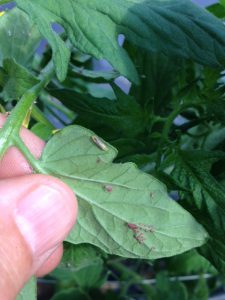Sweet Corn
Cold temperatures are slowing corn growth considerably. The same weather is also delaying the onset of pests like the European corn borer (ECB). No ECB were captured in blacklight traps this week. As the population develops, look for maps to be published in the weekly IPM Update.
Cole Crops
Although cold weather and heavy rains have suppressed them, IPM personnel continue to observe infestations of crucifer flea beetle. These beetles can build to high populations quickly, especially where wild mustard and related cruciferous weeds are common. Extreme feeding on small transplants can cause irreversible damage if not controlled promptly.
While flea beetles may be controlled with foliar applied insecticides, it is possible to get 2-3 weeks of protection by using a soil applied systemic insecticide at planting. This insures good establishment of the transplants without significant flea beetle injury.
Soil applied materials include (active ingredient – trade name (IRAC* code)):
Clothianidin – Belay (4A)
Cyantranilaprole – Verimark (28)
Dinotefuran – Scorpion/Venom (4A)
Imidacloprid – Admire Pro (4A)
OMRI listed foliar materials that will provide some temporary control of flea beetles include:
pyrethrin – Pyganic (3A)
pyrethrin + azadirachtin – (Azera) – (3A + UN)
spinosad – Entrust (5)
*Insecticide Resistance Action Committee
Allium Leafminer ( ALM) Update
Infestations of ALM appear to be widespread throughout much of New Jersey, although the most abundant feeding signs have come from early chive plantings. Some feeding has occurred in leeks, garlic and onions, but to a lesser degree. ALM adult catches on sticky cards placed in chive plantings in the central and northern counties appear to have peaked from April 17-26. Catches since then have declined dramatically, and have not rebounded. None of the traps placed from Mercer through Morris County have captured more than 2 ALM adults for the previous 7 days. At present, refer to the document found at the following link for further information on control of this pest: RCE Vegetable Crops Online Resource Center Critical Updates to the Mid-Atlantic Commercial Vegetable Recommendations
Aphid populations have begun to appear in high tunnel tomatoes. These pests often form colonies beneath the surface of leaves and near growing points on the plant. While the plants consist primarily of vegetative growth without fruit, aphids are largely an insignificant pest. If no broad spectrum insecticides are used on the plants, the aphids generally are decimated by predators and parasites before becoming an economic problem. Predators included syrphid (flower) fly maggots (see photo of syrphid maggot with aphids at right) and ladybird beetles. When scouting, take note not just of the aphid populations, but of the presence of these predators. Their appearance is a sign that the aphid population could soon decline as long as predators are not disrupted. Should aphid populations increase to a degree that their droppings are accumulating on the surface of developing fruit, an insecticide that specifically targets these pests may be necessary. See the 2016-17 Commercial Vegetable Production Recommendations for materials that are labeled for aphid control in tomatoes. Avoid broad spectrum insecticide classes such as synthetic pyrethroids as much as possible.


